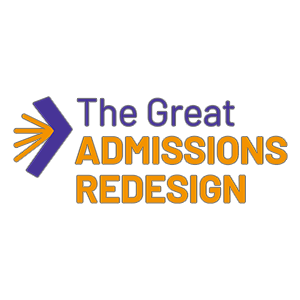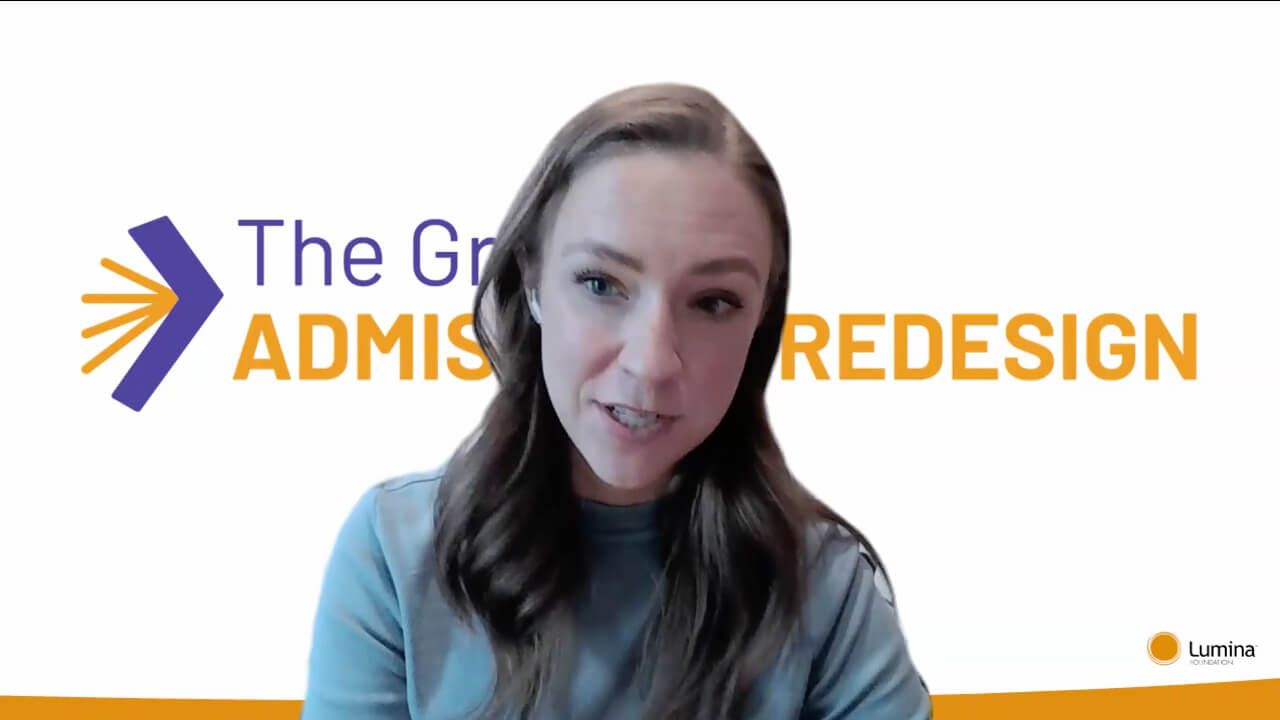Simpler admissions systems provide more opportunity, while complex admissions systems provide less opportunity. The college application process itself represents a barrier to access, especially for students of color, low-income students, and those who would be first in their families to attend college.
Nearly $3M in grants to reimagine higher ed admissions, enrollment, financial aid
Two types of funding are available: planning proposals for 12-month grants for up to $100,000 each and implementation proposals for funding of $500,000 to $750,000 each. Read the full announcement »
What is Lumina looking for?
We invite proposed projects that move the nation toward a higher education system where you can no longer predict whether people will earn a degree based on their race or ethnicity, a system with straightforward admissions, enrollment, and financial aid practices, and one that leads more people toward completion of bachelor’s degree programs.
We seek to support projects that rely on automation, proactivity, and transparency:
- Automation: Limits the work prospective students must undertake to apply.
- Proactivity: Informs prospective students of their educational options before they apply, including how programs align with jobs, and communicates quickly and efficiently with the applicant.
- Transparency: Ensures the admissions eligibility criteria, total costs, and/or financial aid options are clearly conveyed, eliminating uncertainty among applicants.
Lumina is looking for proposals that offer unique ways of automating processes, new ways of recruiting or admitting students, novel ways using data to create seamless processes for prospective students, or other new policies and practices. Innovation does not necessarily mean invention; it can involve taking existing ideas and tying them together in new and interesting ways.
Lumina Strategy Director for Participation Melanie Heath answers questions about applying for The Great Admissions Redesign challenge in a webinar from September 12, 2023.

Ready to apply?
Be sure to watch the webinar, review the application questions, and have all the required documents ready before beginning the process.
Applications are due October 6, 2023.
Why Redesign Admissions?
Helping more Americans earn bachelor’s degrees that position them for further learning and new careers, promotions, and higher wages is essential to meeting the nation’s talent needs. This work is especially important at minority-serving institutions and regional colleges and universities, where students of color and adult students from low- and middle-income families are most likely to start their degrees.
And yet, bachelor’s degree programs are losing students at astounding rates. Since the COVID-19 pandemic, bachelor’s-granting institutions have lost 5.7 percent of students ages 24 and younger, representing 663,000 students, and an additional 570,000 adults 25 and over. Undergraduate enrollment decreases were especially pronounced among students of color: 2022 alone saw a 4.2 percent decrease in Black student enrollment, a 2 percent decrease in Native student enrollment, and 0.5 percent decrease in Hispanic and Latino student enrollment. These patterns will only worsen when the long-anticipated demographic enrollment cliff hits in 2025.
In addition to enrollment declines, the admissions landscape is experiencing once-in-a-generation upheavals. Test-optional policies have become the norm: more than 80 percent of colleges do not require the SAT or ACT for admissions. This creates opportunities for students, particularly students of color. However, one challenge of test-optional admissions policies is the resulting drop in prospective high school student information available to college and university admissions officers. This further complicates the job of admissions and recruitment practitioners, as they have to find different ways to reach students
Many colleges and universities are also reconsidering their application requirements and review processes following recent U.S. Supreme Court rulings limiting race-conscious admissions. As colleges and universities respond, they must avoid placing increased burdens on prospective students.
While navigating this new, under-resourced environment, admissions offices are underwater, experiencing pressures and expectations as never before. Data from the College and University Professional Association for Human Resources revealed that admissions department turnover rates are among the highest in higher education.
These conditions are converging to create a window of opportunity for transformational change in admissions systems that removes barriers to college access. Fixing the process can benefit all students by positioning colleges and universities to meet their needs, which in turn will benefit struggling institutions.
Making complex systems more straightforward is no easy task. Without intentional, transformational, and robust intervention, admissions systems will remain as they are or become even more complex—and more challenging for today’s students. Now is the time to invest in transformational change that will create opportunity for everyone, regardless of race or ethnicity, age, income, or family status.
Eligibility
Lumina will accept applications from:
- State agencies and quasi-public organizations.
- State systems of higher education that include public, nonprofit bachelor’s-granting universities or colleges.
- A group of three (3) or more public or private, nonprofit institutions of higher learning that includes at least one public or private, nonprofit bachelor’s-granting institution(s)
Only one proposal submission per state/higher education system/institutional cluster will be accepted. Lumina encourages collaboration among agencies, organizations, and colleges and universities when developing responses. If multiple responses are received, Lumina will alert the parties and invite them to make a joint submission.
Funding: Planning vs. Implementation
Lumina will consider two types of funding requests:
Planning proposals should come from applicants in the early stages of developing a vision for redesigned admissions, enrollment, and financial aid processes. Lumina anticipates the planning period will end with a strong implementation plan that has sufficient support to be ready to be implemented at the end of the grant period.
Lumina will select up to five (5) entities to submit planning proposals for grants up to $100,000 for a 12-month grant period during the 2024 calendar year. Awards will vary based on the quality of the proposal and the proposed project budget. Lumina will support these grantees as a cohort to encourage peer learning and may provide technical assistance in the planning process.
Implementation proposals should come from applicants with existing work or piloted efforts with redesigned admissions, enrollment, and financial aid processes. Lumina’s resources can be used to enhance, improve, expand, or speed implementation. Lumina anticipates the implementation period will end with tangible policy and practice changes and evidence of effectiveness that can serve as a model or case study for others to follow or learn from.
Lumina will choose up to three (3) entities to submit full grant proposals for funding of $500,000 to $750,000 for a grant period commencing in January 2024 and ending November 2025. Grant awards will vary based on the quality of the proposal and the proposed project budget.
Use of Funds
Lumina funds cannot be spent on scholarships, creating scholarship funds, stipends, or any other form of direct financial support to students. They also cannot be used for lobbying, election, or related activities at the local, state, or federal level or to the general public. Lumina’s funds should be spent on strategic investments that fundamentally alter admissions and enrollment processes within a state, higher education system, or among a group of colleges and universities.
Fund uses may include but are not limited to:
- Building data infrastructure and capacity to transfer data between systems.
- Supporting staffing to build new systems and processes.
- Convening project teams or other stakeholders.
- Commissioning research or hiring consultants.
- Developing new marketing and other collateral materials.
Timeline
Criteria
Lumina will select applicants to submit grant proposals based on their ability to address the following criteria in the challenge application:
- Opportunity: Demonstrated commitment and a clear articulation of how the proposed project will increase educational opportunity for students of color, students from low-income families and first-generation college students.
- Simplicity: Clear articulation of how the project will reduce complexity in admissions and enrollment processes when it comes to automation, proactivity, and transparency.
- Innovation: Clear outline of a fundamentally new or reimagined way of admitting and enrolling students in higher education.
- Readiness: Prior evidence of executing innovative policies and practices and a well-thought-out implementation plan with support of needed stakeholders.
- Admissions and Enrollment Process Map – Current State and Desired Future State. In the application, groups and organizations should submit process maps of their admissions and enrollment steps and a map or maps of the desired future. This will help determine the level of innovation, readiness to undertake the project, and existing areas of friction.
Lumina will select the entities to submit full proposals.
Evaluation
Lumina will conduct an independent, third-party evaluation of the supported projects, including, but not limited to, site visits. Grantees are expected to engage with these outside evaluators on requested data, documents, and/or meetings.
Other Benefits
Applicants and grantees may be invited to join upcoming meetings, events, and other conversations hosted by Lumina and its partners. Organizations chosen to submit grant proposals may be asked to work with Lumina’s communications team to tell stories about their work.
Application questions
The online application will open after the informational webinar on September 12. Here is a preview of the questions you’ll find on the application.
(if planning proposal)
- Describe the problem, barrier, and/or place of friction in your current admissions, enrollment, and/or financial aid process this planning proposal would address.
- Explain how the proposed project will increase educational opportunity for students of color, students from low-income families and first-generation college students.
- How will the proposed project reduce complexity in admissions and enrollment processes, specifically regarding automation, proactivity, and transparency?
- Explain how this is a fundamentally new or reimagined way of admitting and enrolling students in higher education.
- Describe your entity’s capacity to execute innovative policies and practices. How do you plan to develop your implementation plan and build the support of needed stakeholders?
- How would you strategically use the grant funds to plan for an admissions innovation? Why?
- What does success look like at the end of the grant period?
(if implementation proposal)
- Describe your admissions innovation. Has it been piloted? If so, what were the preliminary impacts on postsecondary participation rates?
- Explain how the proposed project will increase educational opportunity for students of color, students from low-income families and first-generation college students.
- How will the proposed project reduce complexity in admissions and enrollment processes, specifically regarding automation, proactivity, and transparency?
- Explain how this is a fundamentally new or reimagined way of admitting and enrolling students in higher education.
- What history of success has your entity shown in executing innovative policies and practices that include a well-thought-out implementation plan and the support of needed stakeholders?
- How would you strategically use the grant funds to implement/expand your admissions innovation? Why?
- What does success look like at the end of the grant period?
Required attachment
Admissions and Enrollment Process Map – Current State and Desired Future State. Please attach process maps of your admissions and enrollment steps and a map/maps of the desired future state. This will help determine the level of innovation, readiness to undertake the project, and existing areas of friction.
Next Steps
Applications are due by 11:59 p.m. EDT October 6. Successful applicants will be notified by October 31. Prospective applicants may send questions to admissionsredesign@luminafoundation.org before the deadline for submitting proposals.
